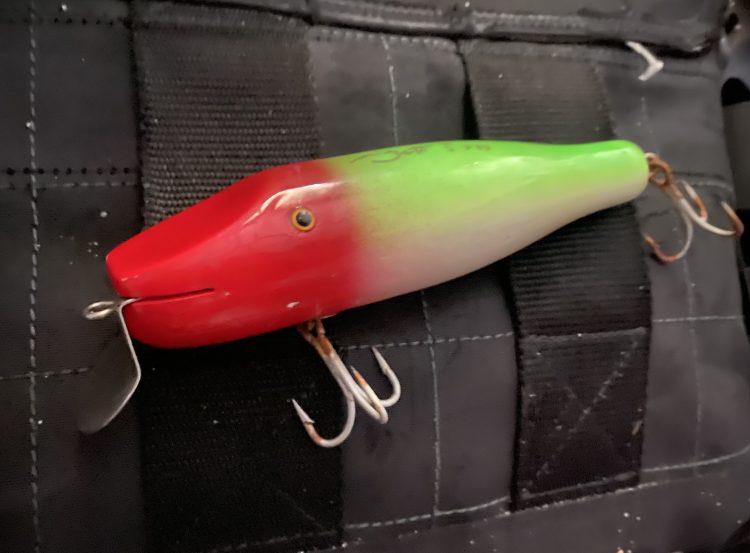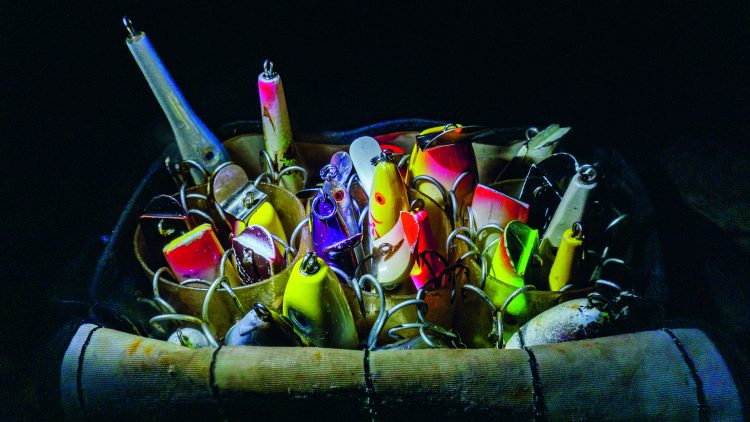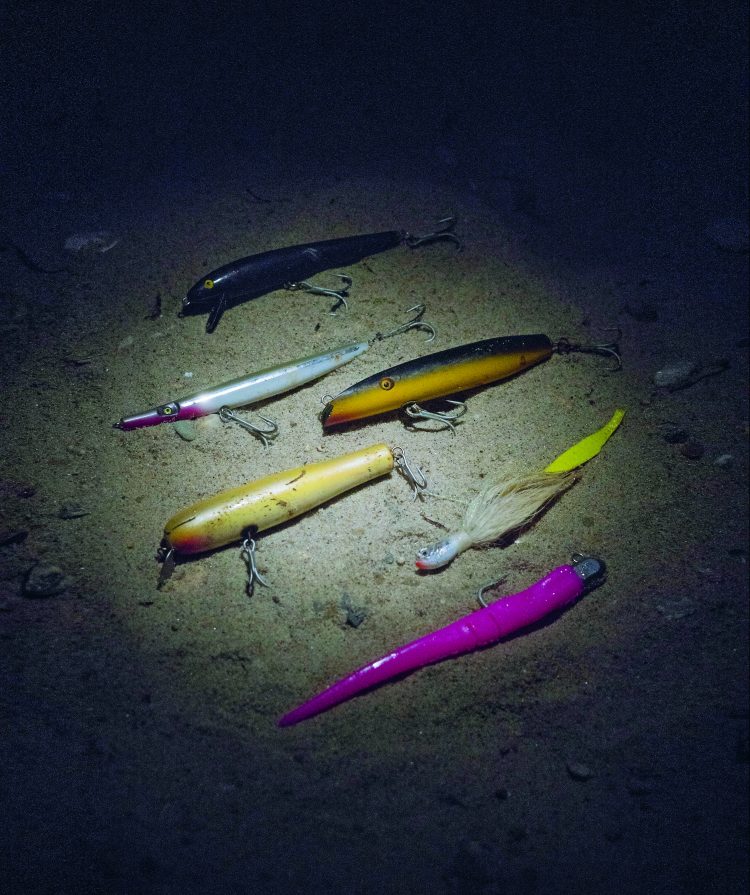Pack a Plug Bag for Surfcasting at Night
Maximize the potential for catching more, and bigger striped bass at night by packing smart and packing light.
I started night-fishing for striped bass because the toll collectors on the bridges were less likely to chase me away after dark. My first season of striper fishing mainly consisted of soaking clams and throwing poppers during mornings and late afternoons, but at that time, the most serious fishermen in South Jersey fished atop the bridges. Fancying myself a serious fisherman, albeit one without a driver’s license, I, too, began to fish the bridges rather than surfcasting at night.
After a few memorable seasons of fishing 40 feet above the water, local authorities started cracking down on bridge fishermen. About the same time, many low-to-the-water causeways were being replaced by higher spans with no fishing access. So, I returned to the surf, but not to daytime fishing.
(Note: On The Water is reader-supported. When you buy through links on our site, we may earn an affiliate commission.)
From the bridges, I had seen how the waters came alive on the after-dark tides. The streetlights flickered on, and before long, schools of bait gathered in the glow, swimming hard to keep from being swept off in the tide. Soon after, larger, dark forms appeared in the shadow lines, holding their positions against the tide with just the slightest sweep of their tails. They were barely recognizable as fish, until a baitfish swam too close to the shadow line, and the dark shape turned broadside as it rolled on the surface, engulfing its evening meal with a loud SMACK!
On my return to the beaches, I learned that the same changing of the guard took place in the surf. The fluke, snapper blues, and kingfish that ruled the shallows by day found themselves one link lower on the food chain when the stripers slid into the surf for their nightly hunts.
For my own nightly hunts, I quickly discovered that I needed to prepare differently than I did for daytime fishing or from the bridges. Fishing effectively at night requires a different approach, and different gear, in order to be successful, and safe.
Three Must-Have Colors for Fishing at Night

There are only three colors you need at night: light, dark, and loud. The bright night/bright colors, dark night/dark colors strategy will serve you well, but I try all three types of colors every night, regardless of moon phase or brightness. On many occasions, I’ve had a white, or light-colored plug catch the biggest fish on a dark night.
On bright nights, I favor loud colors like chartreuse, hot pink, and yellow. I think they work simply because the fish can see them from a distance. This is especially true when big bluefish are around because they feed ravenously on full-moon nights, and the brighter, more obnoxious the color, the more bites you’ll get.

I really like contrasting colors after dark—for example, a white bucktail with a red trailer or a plug with a red-head/light-body paint scheme.
The classic red-head color pattern has almost gone out of style in today’s striper lures, but the relatively few I have account for a big percentage of my larger stripers at night. I’ve seen these patterns out-fish solid colors on many occasions, none so jarring as when my friend landed a 54-pounder on a red-head/white-body plug after I’d been swimming the same plug in all-white through the same water for several casts.
Plug-Packing Tips
Pack Plugs with Less Action for More Fish

I like the fleeing action of a Magic Swimmer or an erratically retrieved soft plastic for triggering reaction strikes during the day, but after dark, slow and steady wins the race.
Stripers hunt differently at night than they do during the day. For all the times I’ve seen stripers pin mackerel against the rocks in the Canal or trap a school of bunker between jetties during the day, I’ve never seen this at night. I’m sure it still happens, but this kind of coordinated blitzkrieg on a school of baitfish requires some level of visibility. While stripers see and sense more than we do at night, that sensory perception is still limited by the lack of visibility.
After dark, stripers take their prey by surprise, waiting in ambush behind a bridge piling or boulder, or slowly cruising a transition zone between deep and shallow water or rocks and sand. These bass, especially if they’re large, are looking for unsuspecting prey, so they might let a frantically moving lure go by without a second look. A subtle action, like the wandering of a darter, the slow glide of a needlefish, or the flick of a bucktail trailer, is more likely to attract the bass that go bump in the night.
My exception to this “rule” is the bottle plug. In turbulent water, when subtle actions can be lost in the noise and movement of a rip at peak tide or a building surf, the hammering of a bottle plug worked across the current can be the best way to get a striper’s attention. In these cases, the more frantic action mimics a baitfish that isn’t fleeing from a predator, but one that has been overwhelmed by the conditions and is doing its best to avoid being swept away with the tide. This presents an easy meal for the striper as it effortlessly conquers the current with its big, broad tail.
The Nighttime Plug Bag Starter Kit

Darter – The side-to-side slide of a slowly-retrieved darter has claimed many cows after dark. Unlike a swimming plug, you won’t feel a darter working, but any questions about whether it’s swimming will be answered by the sharp strike of a hungry bass.
Slow-Sinking Needlefish – A 7-inch, slow-sinking needlefish like the Super Strike Super “N” Fish is one of the most versatile lures you can throw. This lure works well on open beaches, in boulder fields, and even in swift current. You can control how deep a needlefish swims by how soon you begin the retrieve after the cast, and by where you cast in relation to the current. To fish high in the water column, cast down-current and begin your retrieve immediately after the plug lands, To fish near the bottom, cast up-current and give it time to sink.
1.5-ounce Bucktail Jig and Trailer – Much like the needlefish, the bucktail jig is a versatile lure that can be used to probe the bottom of inlets, beaches, boulder fields, and anywhere stripers swim. While the best size varies by location, a 1.5-ounce jig tied with dense bucktail hair seems to have the widest range of applications.
Soft-Plastic Stickbait Rigged Weightless or on a Light Jighead – A slow, steadily retrieved soft-plastic stickbait is an after-dark killer. Use it with or across the current for a natural look that stripers can’t resist.
“Old School” Minnow Plug – While new-age, weight-transferring, beautifully colored minnows are far and away the best baits for daytime, in the nighttime surf, the lazier action and bulkier profile of a Red Fin or Bomber Long A will draw more strikes.
Subsurface Metal Lip – There are many styles to choose from, but a metal lip that swims below the surface is a must-have for imitating large baitfish. On a slow retrieve, the wide wobble of a metal lip sends wounded baitfish vibrations throughout the water column.
Related Content
2 on “Pack a Plug Bag for Surfcasting at Night”
-
Emil I think your article is great I have never fished at night except on a party boat for blue. Those days or nights I should say are long gone. I just might have to give this night fishing a shot. Thanks for all the info.
-
Kevin rodriguez Very good information.
Leave a Reply